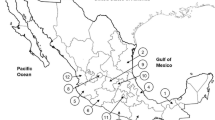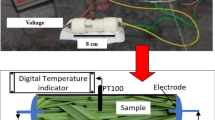Abstract
Producing high quality essential oil from Eucalyptus globulus leaves, distillation is the primary method that is both economical and environmentally friendly. In order to improve the producing process, provide renewal information as reference for further practical applications, the effects of the storage conditions (air-drying, freezing, chilling, and oven-assisted drying) as well as the grinding (less than 4.75, 4.75–9.50, 9.50–22.40, and greater than 22.40 mm), ultrasound (ultrasonic cleaning bath, ultrasonic homogenizer), and agitation treatments (0 ~ 100 rpm) of the samples were studied. In addition, the yield differences by different methods (steam distillation and the water distillation) were compared. Considering both the yield and the operation time, the technique, which extracting small-sized (smaller than 4.70 mm) oven-assisted dried leaves with water distillation under an agitation rate of 25 rpm, should be ideal for the production of essential oil.







Similar content being viewed by others
References
Amakura Y, Umino Y, Tsuji S, Ito H, Hatano T, Yoshida T, Tonogai Y (2002) Constituents and their antioxidative effects in eucalyptus leaf extract used as a natural food additive. Food Chem 77:47–56
Ana CS, Isabel MC, Jesús S (2008) Some aspects of dynamic headspace analysis of volatile components in honey. Food Res Int 41:838–848
Babu GDK, Kaul VK (2007) Variations in quantitative and qualitative characteristics of wild marigold (Tagetes minuta L.) oils distilled under vacuum and at NTP. Ind Crop Prod 26:241–251
Barton A (2000) The oil mallee project: a multifaceted industrial ecology case study. J Ind Ecol 3:161–176
Basile A, Jiménez-Carmona MM, Clifford AA (1998) Extraction of rosemary by superheated water. J Agric Food Chem 46:5205–5209
Braga NP, Cremasco MA, Valle RCCR (2005) The effects of fixed-bed drying on the yield and composition of essential oil from long pepper (Piper hispidinervium C.) leaves. Braz J Chem Eng 22:257–262
Cárcel JA, García-Pérez JV, Benedito J, Mulet A (2012) Food process innovation through new technologies: use of ultrasound. J Food Eng 110:200–207
Cheng SS, Huang CG, Chen YJ, Yu JJ, Chen WJ, Chang ST (2009) Chemical compositions and larvicidal activities of leaf essential oils from two eucalyptus species. J Bioresource Technology 100:452–456
Fernández-Pérez V, Jiménez-Carmona MM, Luque de Castro MD (2000) An approach to the static-dynamic subcritical water extraction of Laurel essential oil: comparison with conventional techniques. Analyst 125:481–485
Gamarra FMC, Sakanaka LS, Tambourgi EB, Cabral FA (2006) Influence on the quality of essential lemon (Citrus aurantifolia) oil by distillation process. Chem Eng 23:147–151
Garikapati D, Kiran B, Bikram S (2009) Simulation of Eucalyptus cinerea oil distillation: a study on optimization of 1,8-cineole production. Biochem Eng J 44:226–231
Grosso C, Ferraro V, Figueiredo AC, Barroso JG, Coelho JA, Palavr AM (2008) Supercritical carbon dioxide extraction of volatile oil from Italian coriander seeds. Food Chem 111:197–203
Guo FQ, Huang LF, Zhou SY, Zhang TM, Liang YZ (2006) Comparison of the volatile compounds of atractylodes medicinal plants by headspace solid-phase microextraction-gas chromatography–mass spectrometry. Anal Chim Acta 570:73–78
Hawthorne SB, Krieger MS, Miller Anal DJ (1998) Analysis of flavour and fragrance compounds using supercritical-fluid extraction coupled with gas chromatography. Anal Chem 60:472–477
Hemwimon S, Pavasant P, Shotipruk A (2007) Microwave-assisted extraction of antioxidative anthraquinones from roots of Morinda citrifolia. Ultrason Sonochem 54:44–50
Hou AJ, Liu YZ, Yang H, Lin ZW, Sun HD (2000) Hydrolyzable tannins and related polyphenols from Eucalyptus globulus. J Asian Nat Prod Res 2:205–212
Luque de Castro MD, Jiménez-Carmona MM, Fernández-Pérez V (1999) Towards more rational techniques for the isolation of valuable essential oils from plants. Trac Trends Anal Chem 18:708–716
Martino E, Ramaiola I, Urbano M, Bracco F, Collina S (2006) Microwave-assisted extraction of coumarin and related compounds from Melilotus officinalis (L.) pallas as an alternative to soxhlet and ultrasound-assisted extraction. J Chromatogr A 1125:147–151
Moyler DA (1994) In: Charalambous G (ed) Spices, herbs and edible fungi, spices-recent advance. Elsevier Science, London, pp 1–70
Pathana AK, Bondb J, Gaskin RE (2009) Sample preparation for SEM of plant surfaces. Mater Today 12:32–43
Porto CD, Decorti D (2009) Ultrasound-assisted extraction coupled with under vacuum distillation of flavour compounds from spearmint (Carvone-rich) plants: comparison with conventional hydrodistillation. Ultrason Sonochem 16:795–799
Roldán-Gutiérrez Jannat M, Ruiz-Jiménez J, Luque de Castro MD (2008) Ultrasound-assisted dynamic extraction of valuable compounds from aromatic plants and flowers compared with steam distillation and superheated liquid extraction. Talanta 75:1369–1375
Silva J, Abebe W, Sousa SM, Duarte VG, Machado MIL, Matos FJA (2003) Analgesic and anti-inflammatory effects of essential oils of eucalyptus. J Biores Technol 89:277–283
Schuenzel KM, Harrison MA (2002) Microbial antagonists of food borne pathogen on fresh minimally processed vegetables. J Food Prot 65:1909–1915
Toma M, Vinatore M, Paniwnyk L, Mason TJ (2011) Investigation of the effects of ultrasound on vegetal tissues during solvent extraction. Ulrasonics Sonochem 8:137–142
Usai M, Marchetti M, Foddai M, Caro AD, Desogus R, Sanna I, Piga A (2011) Influence of different stabilizing operations and storage time on the composition of essential oil of thyme (Thymus officinalis L.) and rosemary (Rosmarinus officinalis L.). LWT Food Sci Technol 44:244–249
Vieira RF, Simon JE (2000) Chemical characterization of basil (Ocimum spp.) found in the markets and used in traditional medicine in Brazil. Econ Bot 54:207–216
Vongsangnak W, Gua J, Chauvatcharin S, Zhong JJ (2004) Towards efficient extraction of notoginseng saponins from cultured cells of Panax notoginseng. Biochem Eng J 18:115–120
Zhang HF, Yang XH, Wang Y (2011) Microwave assisted extraction of secondary metabolites from plants: current status and future directions. Trends Food Sci Technol 22:672–688
Zhang XZ, Gao HJ, Zhang LF, Liu DH, Ye XQ (2012) Extraction of essential oil from discarded tobacco leaves by solvent extraction and steam distillation, and identification of its chemical composition. Ind Crop Prod 39:162–169
Author information
Authors and Affiliations
Corresponding author
Additional information
Highlights
• Comparing to storage condition of chilling, both drying and freezing presented high productivity
• By the storage method of oven-assisted drying the loss of the volatile organics during the grinding step decreased
• Water distillation can speed up the production rate, comparing to steam distillation
• Water distillation provided positive effect on dried leaves but negative effect on frozen ones
• As stirring rate increased, distillation efficiency was enhanced and then held constant
Rights and permissions
About this article
Cite this article
Mei, XY., Kitamura, Y., Takizawa, K. et al. Pretreatment and distilling processes of Eucalyptus globulus leaves for enhancing essential oil production. Biomass Conv. Bioref. 4, 285–292 (2014). https://doi.org/10.1007/s13399-013-0113-3
Received:
Revised:
Accepted:
Published:
Issue Date:
DOI: https://doi.org/10.1007/s13399-013-0113-3




